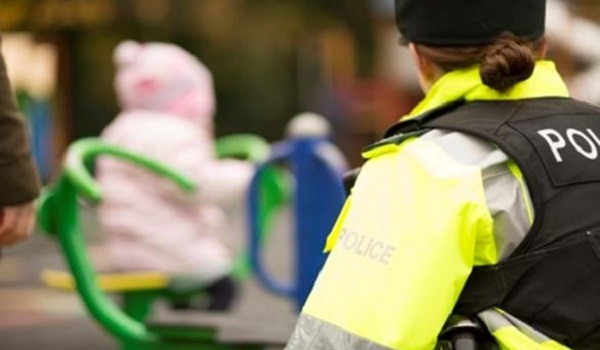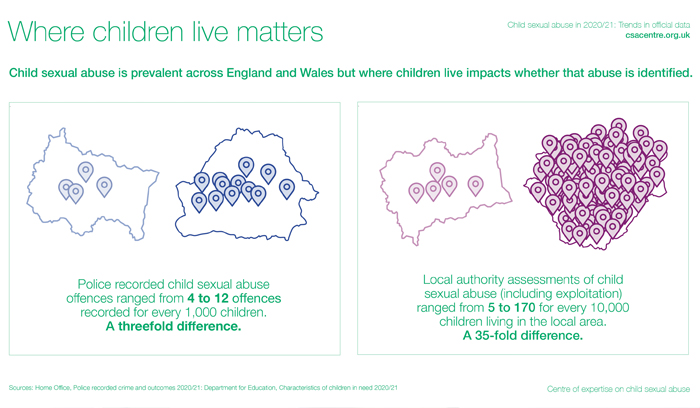‘Worryingly inconsistent’ picture of identification and response to child sexual abuse, report finds
Conservative estimates suggest that that at least one in ten children are sexually abused before the age of 16, yet the gap between the estimated prevalence of child sexual abuse and what is recorded in official data is considerable, according to a new report.
Data across child protection, criminal justice and health agencies in England and Wales reveals services are identifying and responding to only a “small minority” of child sexual abuse cases, with a “worryingly inconsistent” response across local areas.
The Centre of expertise on child sexual abuse (CSA Centre) report – Child sexual abuse in 2020/21: Trends in official data – shows that police forces in England and Wales recorded 89,200 identifiable child sexual abuse offences (including offences involving child sexual abuse images) during the year, slightly more than in 2019/20. Of these, more than one-third were image offences, a further one-third related to rape or sexual assault, and the remainder related to sexual activity with a child, sexual grooming and abuse through sexual exploitation.
Notably, child sexual abuse image offences rose by 18 per cent, the largest single-year increase since 2003/04, says the report.
Within that same year, just one in seven police investigations ended in the suspect being charged, summonsed, cautioned or given ‘diversionary or intervention activity’.
“Investigations were closed most commonly due to evidential difficulties,” says the report. “Over the past seven years, there has been a sharp decline in the proportion of child sexual abuse offence investigations ending in a charge, from nearly one-third in 2014/5, to just ten per cent in 2018/19, before increasing to 12 per cent in 2020/21.”
Local authority children’s services in England recorded concerns about child sexual abuse in 29,640 assessments of children and concerns about child sexual exploitation in 16,830 assessments.
However, just 2,450 children in England – approximately one-twentieth of the children assessed at risk – were placed on a child protection plan under the category of sexual abuse, the report found.
Figures show the number of child protection plans for child sexual abuse fell by six per cent in 2020/21, following a 12 per cent reduction the previous year.
“This is equivalent to 500 fewer children under 18 placed on a child protection plan due to sexual abuse than two years earlier,” says the report. “In Wales, 221, or six per cent, of all child protection registrations were made under the category of sexual abuse.”
The report adds: “The continued falling trend in child protection plans due to sexual abuse is of great concern, but there is also stark contrast between rates reported in local areas when compared to the local child population.
“In the year 2020/21, nearly two thirds of local authorities in England – including the majority of those in inner London – placed five children or fewer on a child protection plan under the category of sexual abuse for every 10,000 living in the local area. Half of all local authorities in Wales also placed no or fewer than five children on the child protection register for child sexual abuse.
“At the other end of the spectrum, ten local authorities in England and Wales placed between five and nine children for every 10,000 living in the local area.”
The highest rates were recorded in the local authorities in West Midlands and Yorkshire and the Humber regions.
A more significant variation was found in the number of children assessed as at risk of child sexual abuse. The report found two local authority children services identified no children for whom they had concerns about sexual abuse, while five local authorities identified more than 70 for every 10,000 children living in the area. Here the highest rates of identification were found in the local authorities in the North East and in Yorkshire and the Humber, while London councils tended to identify fewer cases.
As with child protection services, the report found a wide disparity between local areas in policing, with a threefold difference in the rate of recorded child sexual abuse offences, relative to their child population. This tended to be lowest in police forces in London and the South East, while police forces in the North East, the North West and Yorkshire and Humberside had the highest average recording rates.
However, the report notes that these are the “average rates” within each region, with wide differences in rates across regions between individual police forces/local authorities.
Sexual assault referral centres (SARCs) in England saw 7,244 children during the year – up 20 per cent on the previous year. Again, the report found the reach of SARCs also varied widely across the seven health regions, with London having the lowest and the South West the highest reach among under-18s.
Ian Dean, director of the CSA Centre, said: “There is a pressing need for local leaders to understand and address the large geographical variation in the identification of child sexual abuse, so that where children live does not affect how likely it is that their abuse is identified, detected or responded to.
“We need to look beyond the numbers to really understand what children’s experiences are. Areas with low numbers of recorded cases may assume they have low levels of sexual abuse but we know from prevalence data that this is simply not the case. With 500,000 children under 16 estimated to experience some form of child sexual abuse each year, the significantly lower levels identified in official data indicates that services are failing to identify and address what we know is a challenging, but very worrying and hidden problem.
“We continue to push for better training of all professionals – without greater knowledge, skills and confidence across the children’s workforce we will continue to fail the vast majority of children who are sexually abused.
“Alongside this we urgently need better consistency in data recording to allow us to understand what is driving these variations in response and tackle them, without delay.”
Read the full report at http://www.csacentre.org.uk/our-research/the-scale-and-nature-of-csa/



